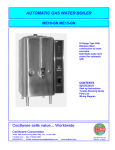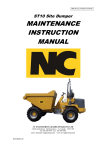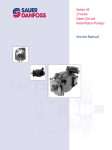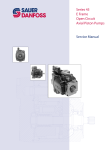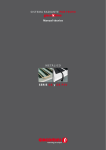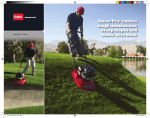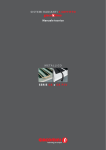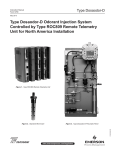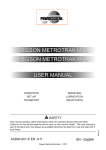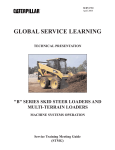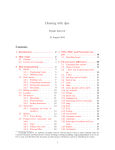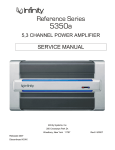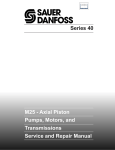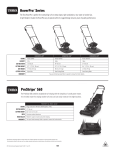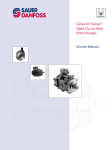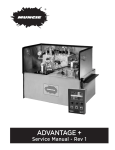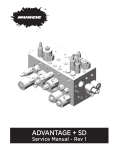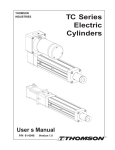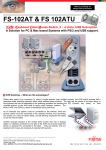Download Product Information - Series 45 Piston Pumps
Transcript
saue Series 45 Axial Piston Open Circuit Pumps Service Manual saue Series 45 Service Introduction 1. Introduction 1.1 Using This Manual This manual includes information for the normal operation, maintenance, and service of the Series 45 family of open circuit pumps. The manual includes a description of the units and their individual components, troubleshooting information, adjustment instructions and minor repair procedures. Unit warranty obligations should not be affected if maintenance, adjustment and minor repairs are performed according to the procedures described in this manual. Many service and adjustment activities can be performed without removing the unit from the vehicle or machine. However, adequate access to the unit must be available, and the unit must be thoroughly cleaned before beginning maintenance, adjustment, or repair activities. Since dirt and contamination are the greatest enemies of any type of hydraulic equipment, cleanliness requirements must be strictly followed. This is especially important when changing the system filter and during adjustment and repair activities. A worldwide network of Sauer-Sundstrand Authorized Service Centers is available should repairs be needed. Contact any Sauer-Sundstrand Authorized Service Center for details. A list of all Service Centers can be found in bulletin BLN-2-40527, or in brochure SAW (Ident. No. 698266). 1.2 Safety Precautions Always consider safety precautions before beginning a service procedure. Protect yourself and others from injury. The following general precautions should be taken into consideration whenever servicing a hydrostatic system. Disable Work Function Fluid Under High Pressure WARNING Certain service procedures may require the vehicle / machine to be disabled (wheels raised off the ground, work function disconnected, etc.) while performing them in order to prevent injury to the technician and bystanders. Flammable Cleaning Solvents WARNING Some cleaning solvents are flammable. To avoid possible fire, do not use cleaning solvents in an area where a source of ignition may be present. WARNING Use caution when dealing with hydraulic fluid under pressure. Escaping hydraulic fluid under pressure can have sufficient force to penetrate your skin causing serious injury. This fluid may also be hot enough to cause burns. Serious infection or reactions can develop if proper medical treatment is not administered immediately. Personal Safety WARNING Proper safety equipment, including safety glasses, should be used at all times. Copyright ©1999, Sauer-Sundstrand Company, All Rights Reserved. 2 Printed in U.S.A. 0899H saue Series 45 Service Introduction Contents 1. Introduction .............................................................................................................................................. 2 1.1 Using This Manual .............................................................................................................................. 2 1.2 Safety Precautions .............................................................................................................................. 2 1.3 Symbols Used in Sauer-Sundstrand Literature ................................................................................... 5 2. Functional Description ............................................................................................................................. 6 2.1 General Description and Cross Sectional Views ................................................................................ 6 2.1.1 Open Circuit Pump Design ........................................................................................................ 6 2.1.2 Basic Pump Operation .............................................................................................................. 7 2.2 The System Circuit .............................................................................................................................. 7 2.3 Pump Features ................................................................................................................................... 8 2.3.1 Displacement Limiters ............................................................................................................... 8 2.3.2 Auxiliary Mounting Pads ............................................................................................................ 8 2.3.3 Input Shafts ............................................................................................................................... 8 2.5 Pump Control Options ........................................................................................................................ 9 2.5.1 Pressure Compensator (PC) Control ........................................................................................ 9 2.5.2 Load Sensing (LS) Control ...................................................................................................... 10 3. Technical Specifications ......................................................................................................................... 11 3.1 General Specifications ...................................................................................................................... 11 3.1.1 Design ..................................................................................................................................... 11 3.1.2 Type of Mounting ..................................................................................................................... 11 3.1.3 Auxiliary Mounting Pad Options .............................................................................................. 11 3.1.4 Control Options ....................................................................................................................... 11 3.1.5 Port Connections ..................................................................................................................... 11 3.1.6 Direction of Rotation ................................................................................................................ 11 3.1.7 Installation Position ................................................................................................................. 11 3.2 Circuit Diagrams ............................................................................................................................... 11 3.3 Hydraulic Parameters ....................................................................................................................... 12 3.3.1 Inlet Pressure .......................................................................................................................... 12 3.3.2 Pressure Compensator Valve Setting ...................................................................................... 12 3.3.3 Case Pressure ......................................................................................................................... 12 3.3.4 Hydraulic Fluid ......................................................................................................................... 12 3.3.5 Temperature Range ................................................................................................................. 12 3.3.6 Fluid Viscosity Limits ............................................................................................................... 12 3.3.7 Filtration ................................................................................................................................... 12 3.4 Technical Data .................................................................................................................................. 13 4. Pressure Measurement ........................................................................................................................... 14 4.1 Required Tools .................................................................................................................................. 14 4.2 Port Locations and Pressure Gauge Installation .............................................................................. 14 4.2.1 57 cc Frame Size .................................................................................................................... 14 4.2.2 74 cc Frame Size .................................................................................................................... 15 5. Initial Start-up Procedures ..................................................................................................................... 16 6. Fluid and Filter Maintenance .................................................................................................................. 17 7. Troubleshooting ...................................................................................................................................... 18 7.1 Excessive Noise and / or Vibration ................................................................................................... 18 7.2 System Operating Hot ...................................................................................................................... 18 7.3 Actuator Response is Sluggish ......................................................................................................... 18 7.4 Low Pump Output Flow ..................................................................................................................... 19 7.5 Pressure Compensator Not Reaching PC Setting ............................................................................ 20 7.6 High Inlet Vacuum ............................................................................................................................. 20 7.7 Pressure or Flow Instability ............................................................................................................... 20 3 saue Series 45 Service Introduction Contents (continued) 8. Adjustments ............................................................................................................................................ 8.1 Pressure Compensator (PC) Control Adjustments ........................................................................... 8.1.1 57 cc Frame Size .................................................................................................................... 8.1.2 74 cc Frame Size .................................................................................................................... 8.2 Load Sensing (LS or LB) Control Adjustment ................................................................................... 8.2.1 57 cc Frame Size .................................................................................................................... 8.2.2 74 cc Frame Size .................................................................................................................... 8.3 Displacement Limiter Adjustment .................................................................................................... 9. Minor Repair Instructions ....................................................................................................................... 9.1 Shaft Seal Replacement ................................................................................................................... 9.2 Displacement Piston and Maximum Displacement Limiter ............................................................... 9.3 Bias Piston ....................................................................................................................................... 9.4 Auxiliary Pads ................................................................................................................................... 9.5 Control Personality Conversion, 57cc Only ....................................................................................... 9.6 Pressure Compensator (PC) Control Pilot Stage and Gain Orifice ................................................... 9.6.1 57 cc Frame Size .................................................................................................................... 9.6.2 74 cc Frame Size .................................................................................................................... 9.7 Load Sensing (LS or LB) Control or Pressure Compensator (PC) Second Stage ............................ 9.7.1 57 cc Frame Size .................................................................................................................... 9.7.2 74 cc Frame Size .................................................................................................................... 9.8 Plug and Fitting Torques ................................................................................................................... 9.8.1 57 cc Frame Size .................................................................................................................... 9.8.2 74 cc Frame Size .................................................................................................................... 10. Exploded Views ..................................................................................................................................... 10.1 57 cc Frame Size .......................................................................................................................... 10.2 74 cc Frame Size .......................................................................................................................... 10.3 Auxiliary Pad Adapters ................................................................................................................... 4 22 22 22 23 24 24 25 26 28 28 29 30 31 32 33 33 34 35 35 36 37 37 38 40 40 42 46 saue Series 45 Service Introduction 1.3 Symbols Used in Sauer-Sundstrand Literature DANGER! May result in injury. Lubricate with hydraulic fluid. May result in immediate or premature damage. Apply grease / petroleum jelly. Reusable part Apply locking compound. Nonreusable part, use a new part. Inspect for wear or damage. Non-removable item Clean area or part. “OR” in drawing – either option may exist. Be careful not to scratch or damage. Measurement required. Note correct orientation. Flatness specification Mark orientation for reinstallation. Parallelism specification Torque specification External hex head Press in. Internal hex head Pull out with tool. Torx head Use installation sleeve / cone "bullet". Tip, helpful suggestion The symbols above can be found in the illustrations and text of this manual. They are intended to communicate helpful information at the point where it is most useful to the reader. In most instances, the appearance of the symbol itself denotes its meaning. The legend above is provided to define each symbol and explain its purpose. 5 saue Series 45 Service Functional Description 2. Functional Description 2.1 General Description and Cross Sectional Views 2.1.1 Open Circuit Pump Design Sauer-Sundstrand Series 45 open circuit pumps convert input torque into hydraulic power. A rotating cylinder block containing axial pistons which are forced in and out of their bores by the angle of a swashplate, results in a specific amount of fluid being displaced for every revolution of the cylinder block. The slipper attaches to the end of the piston by means of a ball and socket joint. This allows the slipper to tilt at any angle while maintaining contact with the swashplate. The face of the slipper pad slides on a hydrostatic fluid film which uses fluid pressure to balance internal forces. The displacement per revolution will change as the swashplate angle changes. The swashplate angle is controlled by the displacement piston. The bias piston acts to return the pump swashplate to max angle. Displacement Piston Cylinder Block Kit Swashplate Tappered Roller Bearing Tappered Roller Bearing Shaft Seal Valve Plate Slipper Bias Piston Piston P101 038E 6 saue Series 45 Service Functional Description 2.1 General Description and Cross Sectional Views (continued) 2.1.2 Basic Pump Operation Series 45 pumps utilize a cradle swashplate design with a hydraulic control piston. Control is provided through a built-in compensator valve. This compensator will shift the pump displacement from maximum to minimum when the set pressure is reached. Controls are also available for remote compensators and load sensing systems. An available displacement adjustment screw allows the maximum flow to be adjusted to match system requirements. These controls are designed for low hysteresis and responsive performance. 2.2 The System Circuit The pump receives fluid directly from the reservoir without the requirement of a charge pump. Fluid is then pumped under pressure to the system and returns directly to the reservoir. When the pump’s automatic control is activated, fluid is ported to the displacement piston. This action destrokes the swashplate (reduces pump displacement) to obtain the desired pump flow. The speed of the actuator (cylinder, hydraulic motor, etc.) depends on the volume of fluid being pumped. The operating pressure depends on the actuator load. The control can position the swashplate at any angle between it’s maximum and zero displacement to provide the pump flow necessary to maintain the setting of the control. If the actuator is to be reversed, a direction control valve is necessary as the pump swashplate operates on one side of neutral only and the pump is unidirectional. To System From System Heat Exchanger B X Return Filter M2 M4 L1, L2 S P101 039E 7 saue Series 45 Service Functional Description 2.3 Pump Features To meet the requirements of various applications, the Series 45 pumps are available with various options which change the operation of the pump. Adjustment Screw 2.3.1 Displacement Limiters Series 45 pumps are available with an optional maximum displacement limiter. This mechanical stop can limit the maximum displacement of the pump to any value from maximum to 75% displacement. Lock Nut P101 040E 2.3.2 Auxiliary Mounting Pads Auxiliary mounting pads are available for all radial ported Series 45 pumps. These pads are typically used for mounting auxiliary hydraulic pumps. Since the auxiliary pad operates under case pressure, an o-ring must be used to seal the auxiliary pump mounting flange to the pad. The driving coupling is lubricated by oil from the main pump case. P101 041 2.3.3 Input Shafts Series 45 pumps are available with a variety of splined, straight keyed, and tapered end shafts. 8 saue Series 45 Service Functional Description 2.5 Pump Control Options 2.5.1 Pressure Compensator (PC) Control The pressure compensator control is designed to maintain a constant pressure in the hydraulic circuit as flow varies. When the system pressure at the pump outlet drops below the compensator setting, the control will increase the pump displacement to maximum (maximum flow). Once the system pressure reaches the compensator setting, the control will regulate pump displacement to produce an output flow which will maintain system pressure at the compensator setting. Gain - bar [psi] per turn PC nd 2 Stage 57 cc 74 cc 88.94 [1290] 42.06 [610] 17.93 [260] ---------T101 092E The pressure compensator setting is adjustable. The setting range for the pressure compensator is from 100 to 280 bar [1450 to 4060 psi]. Refer to Section 8, page 22, for adjustment procedures. Note: On 57cc pumps built after serial number A-98-21-XXXXX, tamper resistant hardware is installed on the PC & second stage adjustment screws. This will allow only one complete clockwise turn from the original factory setting. Second Stage Adjustment Screw PC Adjustment Screw 57 cc 74 cc PC Adjustment Screw P101 042E 9 saue Series 45 Service Functional Description 2.5 Pump Control Options (continued) 2.5.2 Load Sensing (LS) Control The load sensing control is designed to match pump outlet flow and pressure with system demand. When the control valve is “centered,” the load sensing port on the pump is drained to the reservoir through a bleed orifice located either in the control valve or the pump housing. This maintains a standby pressure at the pump outlet equal to the load sense setting. When the external control valve is actuated, the load sensing port sees the load pressure. The pump control then adjusts the pump output flow to maintain a constant pressure drop (equal to the load sensing setting) across the external control valve. The pump thereby provides flow to the load as demanded by the external control valve position. The load sensing setting is adjustable. The setting range for the load sensing control is from 10 to 30 bar [145 to 435 psi]. Refer to section 8, page 24, for adjustment procedures. Gain - bar [psi] per turn 57 cc 74 cc PC 88.94 [1290] 42.06 [610] LS 17.93 [260] 17.24 [250] T101 093E Note: On 57cc pumps built after serial number A-98-21-XXXXX, tamper resistant hardware is installed on both the PC & LS adjustment screws. This will allow only one complete counter clockwise turn from original factory setting. LS Port PC Adjustment Screw 57 cc LS Adjustment Screw 74 cc PC Adjustment Screw LS Port P101 043E 10 saue Series 45 Service Technical Specifications 3. Technical Specifications 3.1 General Specifications 3.1.1 Design 3.1.5 Port Connections Open circuit axial piston pumps of cradle swashplate design with variable displacement. Inlet and pressure ports: SAE Flange Ports, Code 61 Axial (end) ports or radial (side) ports All other: SAE straight thread o-ring boss 3.1.2 Type of Mounting SAE flange, Size C (SAE J744) mounting pad SAE flange, Size B optional for 57cc pump only 3.1.6 Direction of Rotation 3.1.3 Auxiliary Mounting Pad Options 3.1.7 Installation Position SAE flange, Size A, B, B-B, or C Installation position discretionary. The housing must always be filled with hydraulic fluid. 3.1.4 Control Options PC: LS: Clockwise or counterclockwise Pressure Compensator Load Sensing (with Pressure Compensator) 3.2 Circuit Diagrams Series 45 74 cc variable displacement pump with pressure compensator / load sensing control Series 45 57 cc variable displacement pump with pressure compensator / load sensing control B B X * X * M2 M2 M4 *optional M4 L1,L2 S P101 103 *optional L1,L2 S P101 102 Ports: B S L1, L2 X M2 M4 = = = = = = Main pressure line Suction line Case drain lines Load sense line Gauge port for port "B" Gauge port - servo pressure Ports: B S L1, L2 X M2 M4 = = = = = = Main pressure line Suction line Case drain lines Load sense line Gauge port for port "B" Gauge port - servo pressure 11 saue Series 45 Service Technical Specifications 3.3 Hydraulic Parameters 3.3.1 Inlet Pressure 3.3.5 Temperature Range1 Minimum pressure, continuous = 0.8 bar absolute [23.2 in Hg] Intermittent, cold start Continuous Maximum (at reduced maximum pump speed) Minimum pressure, cold start = 0.5 bar absolute [14.8 in Hg] = = = - 40° C [- 40° F] 82° C [180° F] 104° C [220° F] (at the hottest point, i.e. drain line) 1. Hydraulic fluid viscosity must be maintained within the prescribed limits. 3.3.2 Pressure Compensator Valve Setting 3.3.6 Fluid Viscosity Limits Minimum pressure: 100 bar [1450 psi] mm2/s (cSt) SUS (Saybolt Universal Seconds) Maximum continuous: 0.5 bar [7 psi] Above inlet Intermittent: 2 bar [29 psi] Cold start n n n n 58 min. continuous 47 intermittent 500 max. continuous 4700 intermittent, cold start 3.3.4 Hydraulic Fluid 3.3.7 Filtration Refer to Sauer-Sundstrand publication BLN-9887 or 697581. Refer to publication ATI-E 9101 for information relating to biodegradable fluids. Required cleanliness level: ISO 4406 Class 18/13 or better. Refer to Sauer-Sundstrand publication BLN9887 or 697581 and ATI-E 9201. Maximum pressure: 280 bar [4060 psi] 3.3.3 Case Pressure 12 min min max max = 9 = 6.4 = 110 = 1000 saue Series 45 Service Technical Specifications 3.4 Technical Data Dimension Frame Size 057 074 cm [in ] 57 [3.48] 74 [4.52] Minimum min-1 (rpm) 500 500 Rated* min-1 (rpm) 2600 2400 Maximum* min-1 (rpm) 3200** 2800** Maximum (Peak) Working Pressure bar [psi] 350 [5075] 350 [5075] Continuous Working Pressure bar [psi] 280 [4060] 280 [4060] Flow at Rated Speed l/min [US gal/min] 148.2 [39.5] 177.6 [47.4] Theoretical Input Torque at Maximum Displacement Nm/bar [lbf·in/1000 psi] 0.907 [554] 1.178 [720] Mass Moment of Inertia of the Internal Rotating Parts kg·m2 [lbf·ft2] 0.0043 [0.1014] 0.0063 [0.1500] Axial Ported Units kg [lb] 24 [53] 29 [63] Radial Ported Units kg [lb] 27 [60] 36 [80] Displacement Input Speed Weight 3 3 T101 119E * Refer to General Technical Specifications in Series 45 Axial Piston Open Circuit Pumps Technical Information Manual, BLN-10128. ** With pressurized inlet. 13 saue Series 45 Service Pressure Measurement 4. Pressure Measurement 4.1 Required Tools The service procedures described in this manual for Series 45 pumps can be performed using common mechanic’s hand tools. Special tools, if required are shown. Pressure gauges should be calibrated frequently to ensure accuracy. Snubbers are recommended to protect pressure gauges. 4.2 Port Locations and Pressure Gauge Installation The following sections list the gauge ports for each frame size. The recommended pressure gauge and fitting are also specified. Outline drawings showing port locations follow the tables. 4.2.1 57 cc Frame Size M2 System Pressure 300 bar or 5000 psi gauge 7/16 — 20 o-ring Fitting L1 Case L2 Pressure 10 bar or 100 psi gauge 7/8 — 14 o-ring Fitting (057) M4 Control Piston 300 bar or 5000 psi gauge 7/16 — 20 o-ring Fitting X1 LS Signal 300 bar or 5000 psi gauge Tee into LS Signal Line 7/16 — 20 o-ring Fitting LS Signal Port X* Remote PC Signal Case Drain Port L2 Servo Pressure Gauge Port Port M4 System Output Port B System Inlet Port S *This port is plugged on pumps with PC control Case Drain Port L1 System Pressure Gauge Port Port M2 Base Unit Shown with PC / LS Control and Axial End Cap Ports (LH Rotation) 14 P101 050E saue Series 45 Service Pressure Measurement 4.2 Port Locations and Pressure Gauge Installation (continued) 4.2.2 74 cc Frame Size M2 System Pressure 300 bar or 5000 psi gauge 7/16 — 20 o-ring Fitting L1 Case L2 Pressure 10 bar or 100 psi gauge 7/8 — 14 o-ring Fitting (074) M4 Control Piston 300 bar or 5000 psi gauge 7/16 — 20 o-ring Fitting X1 LS Signal 300 bar or 5000 psi gauge Tee into LS Signal Line 7/16 — 20 o-ring Fitting Case Drain Port L1 LS Signal Port X LS Signal Port X1 Servo Pressure Gauge Port Port M4 System Pressure Gauge Port Port M2 Case Drain Port L2 Base Unit with PC/LS Control and Axial End Cap Ports Shown P101 047E 15 saue Series 45 Service Initial Start-up Procedures 5. Initial Start-up Procedures The following start-up procedure should always be followed when starting-up a new Series 45 installation or when restarting an installation in which the pump has been removed. WARNING The following procedure may require the vehicle/machine to be disabled (wheels raised off the ground, work function disconnected, etc.) while performing the procedure in order to prevent injury to the technician and bystanders. Take necessary safety precautions before moving the vehicle/machine. Prior to installing the pump, inspect the units for damage incurred during shipping and handling. Make certain all system components (reservoir, hoses, valves, fittings, heat exchanger, etc.) are clean prior to filling with fluid. The pump should be connected to the prime mover so that the centers of both shafts are aligned. Incorrect alignment may result in eventual damage to the drive shaft, drive shaft bearings, or the drive shaft seal which can cause external oil leakage. Fill the main pump housing with clean hydraulic fluid prior to start up. Fill by pouring filtered oil directly into the upper most case drain hole. Fill the reservoir with recommended hydraulic fluid. Fluid should always be filtered through a 25 micron filter prior to entering the reservoir. Never reuse hydraulic fluid. 16 The inlet line leading from the pump to the reservoir must be filled prior to start up. Check inlet line for properly tightened fittings and be certain it is free of restrictions and air leaks. To ensure the pump stays filled with oil, the case drain line should be installed in the upper most case drain port. Follow recommendations in the vehicle / machine operator’s manual for prime mover start up procedures. Install a gauge at port M2 to monitor system pressure during start up. Jog the prime mover or run at the lowest possible speed until system pressure builds to normal levels (minimum 11 bar [160psi]). Once system pressure is established, increase the speed to full operating RPM. If system pressure is not maintained, shut down the prime mover, determine the cause, and take corrective action. Refer to Troubleshooting, page 18. Operate the hydraulic system for at least fifteen (15) minutes under light load conditions. It may be necessary to check and adjust control settings after installation. Refer to Adjustments, page 22. Shut down the prime mover and remove the pressure gauge. Check the fluid level in the reservoir, add if necessary. The pump is now ready for operation. saue Series 45 Service Fluid and Filter Maintenance 6. Fluid and Filter Maintenance To ensure optimum service life of Series 45 products, regular maintenance of the fluid and filter must be performed. Contaminated fluid is the main cause of unit failure. Care should be taken to maintain fluid cleanliness while performing any service procedure. It may be necessary to change the fluid more frequently if it becomes contaminated with foreign matter (dirt, water, grease, etc.) or if the fluid has been subjected to temperature levels greater that the recommended maximum. Never reuse hydraulic fluid. Check the reservoir daily for proper fluid level, the presence of water (noted by a cloudy to milky appearance or free water in the bottom of the reservoir), and rancid fluid odor (indicating excessive heat). If either of these conditions occur change the fluid and filter immediately. Dispose of used hydraulic fluid properly. Filters should be changed whenever the fluid is changed or whenever the filter indicator shows that it is necessary to change the filter. Replace all fluid lost during filter change. It is recommended that the fluid and filter be changed per the vehicle / machine manufacturer’s recommendations or at the following intervals: Reservoir Type Maximum Oil Change Interval Sealed 2000 Hours Breather 500 Hours T101 097E 17 saue Series 45 Service Troubleshooting 7. Troubleshooting 7.1 Excessive Noise and / or Vibration Description Item Action 1. Check oil in reservoir. Insufficient hydraulic fluid will lead to cavitation. Fill the reservoir to proper level. 2. Check for air in system. Noisy, erratic control. Purge air and tighten fittings. Check inlet for leaks. 3. Check pump inlet pressure / vacuum. Erratic behavior, low output flow. Correct pump inlet pressure / vacuum conditions. 4. Inspect shaft couplings. A loose or incorrect shaft coupling will cause excessive noise and/or vibration. Repair or replace coupling and check that correct coupling is being used. 5. Inspect shaft alignment. Misaligned shafts will create excessive frictional noise and/or vibration. Correct shaft misalignment. 6. Hydraulic oil improper viscosity. Hydraulic oil viscosity above acceptable limits will cause cavitation at start up. Replace existing fluid with the appropriate viscosity grade fluid. See Hydraulic Fluids, Series 45 Technical Information Manual, BLN-10128. Description Action 1. Check oil in reservoir. Insufficient amount of hydraulic oil will not meet cooling demands of system. Fill the reservoir to proper level. Verify proper size of reservoir. 2. Inspect heat exchanger. Heat exchanger not sufficiently cooling system. Check air flow and input air temperature for the heat exchanger. Clean, repair, or replace heat exchanger. Verify proper size of heat exchanger. 3. Check external system relief valve setting. Relief valve setting below PC setting will create heat. Adjust external system relief valve setting. 4. Check pump inlet pressure/vacuum. High inlet vacuum will create heat. Correct inlet pressure / vacuum conditions. 7.2 System Operating Hot Item 7.3 Actuator Response is Sluggish Item Description 1. Check external system relief valve setting. Low external relief valve setting will slow down system. Adjust external relief valve setting. 2. Check PC and LS control setting. Low PC setting will prevent the pump from achieving full stroke. Adjust PC and LS setting. 3. Check LS control signal pressures. Incorrect LS signal will not allow pump to operate correctly. Inspect system, ensure that proper LS signal is transmitted to the pump. 4. PC control not operating properly. PC control with abnormal wear or contamination will not operate properly. Flush screen in PC cartridge to remove contamination or replace abnormally worn spool. 18 Action saue Series 45 Service Troubleshooting 7.3 Actuator Response is Sluggish (continued) Item Description Action 5. Internal system leaks. Worn internal parts will not allow the pump to operate properly. Repair as required. 6. Hydraulic oil viscosity above acceptable limits. Oil viscosity above acceptable limits or low oil temperature will not allow the pump to fill or control to operate properly. Allow system to warm up before operation or use fluid with the appropriate viscosity grade for expected operating temperatures. See Hydraulic Fluids, Series 45 Technical Information Manual, BLN-10128. 7. Check system valving. Malfunctioning valve may not allow system to respond. Repair or replace system valving. 8. Check pump case pressure. High case pressure will cause the system to be sluggish. Correct case drain line restrictions. 9. Check pump inlet pressure / vacuum. High inlet vacuum will cause cavitation and generate heat. Correct inlet pressure conditions. 7.4 Low Pump Output Flow Item Description Action 1. Check oil in reservoir. Insufficient hydraulic oil level. Fill the reservoir to proper level. 2. Hydraulic oil viscosity above acceptable limits. Oil viscosity above acceptable limits or low oil temperature will not allow the pump to fill or control to operate properly. Allow system to warm up before operation or use fluid with the appropriate viscosity grade for expected operating temperatures. See Hydraulic Fluids, Series 45 Technical Information Manual, BLN-10128. 3. Check external system relief valve setting. External relief valve set below PC setting will cause low flow. Correct external relief valve setting. 4. Check PC and LS control setting. Low PC setting will prevent the pump from achieving full stroke. Low LS setting will prevent adequate flow. Adjust PC and LS setting. See Adjustments, page 22. 5. Check pump inlet pressure / vacuum. High inlet vacuum will cause cavitation and decrease flow. Correct inlet pressure conditions. 6. Check input speed. Low input speeds decrease flow. Adjust input speed. 7. Check pump displacement limiter. Pump displacement limiter may be set below desired flow rate. Adjust displacement limiter to the appropriate setting. See Adjustments, page 26. 8. Check pump rotation. Incorrect rotational configuration will cause low flow. Use pump with appropriate rotational configuration. 9. Check pilot orifice in port X. Restricted control orifice will limit output flow. Inspect and clean control orifice. 10. Verify bleed orifice plug is installed (serial numbers prior to A-97-52-XXXX). If plug is missing, control will not perform correctly. Install bleed orifice plug (C111). See Minor Repair page 33. 19 saue Series 45 Service Troubleshooting 7.5 Pressure Compensator Not Reaching PC Setting Item Description Action 1. Check PC control setting. Pump will not compensate to pressure settings. Adjust PC to appropriate setting. 2. Check external relief valve. PC control cannot be set above an external relief valve setting. Adjust the external relief valve to the appropriate setting. 3. Inspect compensator spring. Broken, damaged, or missing spring will cause erratic operation. Replace spring. 4. Inspect PC poppet (57cc), or spool (74cc) for wear. Abnormal wear of the PC poppet or spool will allow internal leakage in the control. Replace PC cartridge or spool. 5. Inspect compensator spool. Improper orientation will result in poor operation. Correct orientation of spool. 6. Check PC control for contamination. Spool or poppet is held open by contaminants. Clean PC control components and rid system of contamination. 7. Verify bleed orifice plug is installed (serial numbers prior to A-97-52-XXXX). If plug is missing, control will not perform correctly. Install bleed orifice plug (C111). See Minor Repair page 33. Description Action 7.6 High Inlet Vacuum Item 1. Check oil temperature. Cold oil has a higher viscosity. Allow system to warm up before operation. 2. Inspect inlet screen. Restriction will cause high vacuum. Remove restriction / blockage. 3. Check inlet piping. Too many fittings, bends, or long piping will cause high vacuum. Eliminate fittings to make path more direct. 4. Hydraulic oil improper viscosity. Hydraulic oil viscosity above acceptable limits will cause cavitation. Replace existing fluid with the appropriate viscosity grade fluid. See Hydraulic Fluids, Series 45 Technical Information Manual, BLN-10128. 7.7 Pressure or Flow Instability Item Description Action 1. Air in system. Air in system will cause erratic operation. Activate PC, allowing system to bleed air. Check inlet line for leaks. 2. Check control spools. Sticking control spools. Inspect spools for free movement in bore. Clean or replace as needed. 3. Check external relief valve and PC setting. Insufficient pressure differential between pump and external relief valve. Adjust external relief valve or PC control settings to appropriate level. 4. Check external relief valve. Chattering external relief valves may be causing unstable feedback to pump. Adjust or replace relief valve. 5. Check gain orifice-plug (57 cc only). Obstructed gain orifice-plug option may cause instability. Clear or change gain orifice-plug. 20 saue Series 45 Service Troubleshooting Notes: 21 saue Series 45 Service Adjustments 8. Adjustments 8.1 Pressure Compensator (PC) Control Adjustments 8.1.1 57 cc Frame Size WARNING Do not make adjustments or disconnect any hoses until all residual pressure in the system circuit has been released. Take necessary precautions to secure the work function of the machine to prevent injury while performing this procedure. The pressure compensator setting is indicated in the pump model code. Refer to the Technical Information Manual BLN-10128 for more information. Install a pressure gauge in port M2 to measure system pressure. Install a pressure gauge in drain port L1 or L2 to measure case pressure. If a remote PC control is used, disconnect the signal line, cap it, and plug the port. Refer to Pressure Measurement, page 14. Install a pilot hose (6mm [0.25 in] diameter minimum) at port X connecting to the reservoir to drain the remote PC port. Note: Failure to drain port X (spring cavity) to reservoir may cause additional back pressure on the PC spring, resulting in pressure settings above the desired specification. It is recommended that this procedure be used on all Series 45, 57cc pumps, however it is particularly vital to 1999 and newer units due to hardware changes associated with the PC cartridge. Start the prime mover and run at normal speed. While securing the second stage adjustment screw, loosen the seal locknut. Turn the second stage adjustment screw1 until a the gauge at port M22 reads 15 bar [220psi]. Clockwise rotation of the screw will increase pressure, counterclockwise rotation will decrease. While holding the position of the second stage adjustment screw, torque the seal locknut to 23 Nm [17 lbf•ft]. Shut down the prime mover. Disconnect the pilot hose installed at port X and reinstall the plug. Start the prime mover and run at normal speed. Operate a hydraulic function to its full extension, loading the pump at maximum pressure and zero flow. While securing the PC adjustment screw, loosen the seal locknut. Turn the PC adjustment screw1 until the desired setting is indicated on the pressure gauge at port M23. Clockwise rotation will increase pressure, counterclockwise rotation will decrease. If the pressure does not increase, an external system relief valve may need to be adjusted. An external system relief valve should be set above the PC setting for proper operation. While holding the position of the PC adjustment screw, torque the seal locknut to 23 Nm [17 lbf•ft]. Stop the prime mover, remove the pressure gauges, and return the system to its normal operating configuration. Remote PC Port Second Stage Adjustment Screw 13 mm PC Adjustment Screw 13 mm Second Stage Adjustment Seal-Lock Nut 13 mm PC Adjustment Seal Lock Nut 13 mm 23 Nm [17 lbf ft] 23 Nm [17 lbf ft] Port X P101 046E 1. Pumps with serial number greater than A-98-21-XXXX will have tamper resistant hardware installed on both the PC and second stage adjustments. This will only allow one complete clockwise turn from the original factory setting. 22 2. The second stage setting is referenced to the pressure at port X. During this procedure port X is vented to reservoir. 3. PC setting is referenced to case pressure. Subtract case pressure from system pressure to compute the actual setting. saue Series 45 Service Adjustments 8.1 Pressure Compensator (PC) Control Adjustments (continued) 8.1.2 74 cc Frame Size WARNING Do not make adjustments or disconnect any hoses until all residual pressure in the system circuit has been released. Take necessary precautions to secure the work function of the machine to prevent injury while performing this procedure. Install a pressure gauge in port M2 to measure system pressure. Install a pressure gauge in case drain port L1 or L2 to measure case pressure. Refer to Pressure Measurement, page 14. Loosen the PC set screw and turn the adjustment screw counter clockwise to release the spring pressure. Turn until the end of the screw is flush with the housing. Start the prime mover and allow fluid to reach normal operating temperature. Operate the prime mover at normal speed. Operate a hydraulic function to its full extension, loading the pump at maximum pressure and zero flow. Turn the PC adjustment screw until system pressure reaches the desired value, as indicated on the gauge at port M21. Clockwise rotation will increase the setting, counterclockwise rotation will decrease. If the pressure does not increase, an external system relief valve may need adjustment. External system relief valve should be set above the PC setting for proper operation. While holding the position of the PC adjustment screw, torque the setscrew to 6.8 Nm [5 lbf•ft]. Stop the prime mover and remove the pressure gauges installed at port M2, and case drain port L1 or L2. Replace the port plugs. PC Set Screw 4mm 6.8 Nm [5 lbf•ft] PC Adjustment Screw 6mm P101 053E 1. PC setting is referenced to case pressure. Subtract case pressure from system pressure to compute the actual setting. 23 saue Series 45 Service Adjustments 8.2 Load Sensing (LS or LB) Control Adjustment 8.2.1 57 cc Frame Size WARNING Do not make adjustments or disconnect any hoses until all residual pressure in the system circuit has been released. Take necessary precautions to secure the work function of the machine to prevent injury while performing this procedure. pump, but keep the system pressure below the PC set point. While watching the pressure gauges, turn the LS adjustment screw1 until the desired pressure differential between port M2 (system pressure) and the remote PC port (LS signal) is achieved2. Clockwise rotation will increase the setting, counterclockwise rotation will decrease. While holding the position of the adjustment screw, torque the seal locknut to 23 Nm [27 lbf•ft]. Install a pressure gauge in port M2 to measure system pressure. Install a pressure gauge in drain port L1 or L2 to measure case pressure. Install a pressure gauge in the remote PC port. If remote PC is used, temporarily remove the remote PC signal line and cap it. Leave the LS signal line connected. Refer to Pressure Measurement, page 14. Operate a hydraulic function to its full extension loading the pump at maximum pressure and zero flow. While securing the PC adjustment screw, loosen the seal locknut. Turn the PC adjustment screw1 until the desired setting is indicated on the pressure gauge at port M23. Clockwise rotation will increase the setting, counterclockwise rotation will decrease. If the pressure does not increase, an external system relief valve may need to be adjusted. External system relief valve should be set above the PC setting for proper operation. Start the prime mover and allow fluid to reach normal operating temperature. While holding the position of the PC adjustment screw, torque the seal locknut to 23 Nm [17 lbf•ft]. While securing the LS adjustment screw, loosen the seal locknut. Slowly operate a hydraulic function which will demand approximately half flow from the Stop the prime mover, remove the pressure gauges, and return the system to its normal operating configuration. The LS or LB Setting is indicated in the pump model code. Refer to the Technical Information Manual BLN-10128 for more information. PC Adjustment Screw 13 mm PC Adjustment Seal Lock Nut 13 mm Remote PC Port LS Adjustment Screw 13 mm 23 Nm [17 lbf•ft] Port X LS Signal LS Adjustment Seal-Lock Nut 13 mm 23 Nm [17 lbf•ft] P101 048E 1. Pumps with serial number greater than A-98-21-XXXX will have tamper resistant hardware installed on both the PC and second stage adjustments. This will only allow one complete clockwise turn from the original factory setting. 24 2. The LS setting is a differential pressure. Subtract pilot pressure at the remote PC port from system pressure at port M2 to compute the actual setting. 3. PC setting is referenced to case pressure. Subtract case pressure from system pressure to compute the actual setting. saue Series 45 Service Adjustments 8.2 Load Sensing (LS or LB) Control Adjustment (continued) 8.2.2 74 cc Frame Size WARNING Do not make adjustments or disconnect any hoses until all residual pressure in the system circuit has been released. Take necessary precautions to secure the work function of the machine to prevent injury while performing this procedure. The LS or LB Setting is indicated in the pump model code. Refer to the Technical Information Manual, BLN-10128 for more information. Install a pressure gauge in port M2 to measure system pressure. Install a pressure gauge in drain port L1 or L2 to measure case pressure. Install a pressure gauge in port X to measure LS signal pressure. Leave the LS signal line connected, using the opposite port for the gauge. Refer to Pressure Measurement, page 14. Start the prime mover and allow fluid to reach normal operating temperature. Loosen the LS locking set screw. Slowly operate a hydraulic function which will demand approximately half flow from the pump, but keep the system presPort X 3/16 in 12 Nm (9 lbf•ft) sure below the PC set point. While watching the pressure gauges, turn the LS adjustment screw until the desired pressure differential between port M2 (system pressure) and port X (LS signal) is achieved1. Clockwise rotation will increase the setting, counterclockwise rotation will decrease. While holding the position of the adjustment screw, torque the locking set screw to 6.8 Nm [5 lbf•ft]. Operate a hydraulic function to its full extension loading the pump at maximum pressure and zero flow. While securing the PC adjustment screw, loosen the seal locknut. Turn the PC adjustment screw until the desired setting is indicated on the pressure gauge at port M22. Clockwise rotation will increase the setting, counterclockwise rotation will decrease. If the pressure does not increase, an external system relief valve may need to be adjusted. External system relief valve should be set above the PC setting for proper operation. While holding the position of the PC adjustment screw, torque the locking set screw to 6.8 Nm [5 lbf•ft]. Stop the prime mover, remove the pressure gauges, and return the system to its normal operating configuration. LS Locking Set Screw 4mm 6.8 Nm (5 lbf•ft) LS Adjustment Screw 6 mm PC Locking Set Screw 4mm 6.8 Nm (5 lbf•ft) PC Adjustment Screw 6 mm P101 049E 1. The LS setting is a differential pressure. Subtract pilot pressure at port X from system pressure at port M2 to compute the actual setting. 2. PC setting is referenced to case pressure. Subtract case pressure from system pressure to compute the actual setting. 25 saue Series 45 Service Adjustments 8.3 Displacement Limiter Adjustment If equipped, the displacement limiter may be adjusted to achieve a desired maximum flow rate. The preferred method for setting the displacement limiter is to make adjustments while operating the pump at full stroke on an appropriate test apparatus equipped with a flow meter and system pressure gauge. This allows the pump to be set to a specific maximum flow rate under precise speed and pressure conditions. If test apparatus is not available, the following procedure may be used to set an approximate maximum displacement. Remember to verify that the displacement setting is appropriate by operating the pump in its application after adjustment. To adjust the displacement limiter setting remove the displacement piston bore plug with its o-ring. Loosen the seal locknut and turn the displacement limiter adjustment screw counter clockwise until the opposite end is flush with end of the displacement piston bore plug. The setting is now at maximum displacement. Replace the o-ring and install the plug into the pump housing. Torque the displacement piston plug as indicated. Turn the displacement limiter adjustment screw clockwise to set the desired maximum displacement. For 57cc pumps, the displacement is decreased by 5cc per revolution of the displacement limiter adjustment screw; for 74cc pumps, 6cc per revolution. While holding the position of the displacement limiter adjustment screw, torque the seal locknut. WARNING The seal lock nut must be torqued after every adjustment to prevent an unexpected change in pump output and to prevent external leakage during unit operation. Displacement Piston Bore Plug See Table Displacement Limiter Adjustment Screw 6 mm Seal Locknut 19 mm 87 Nm [64 lbf ft] (57 CC Shown) Displacement Piston Bore Plug 57 cc 74 cc Hex Wrench 1 1/4 in 1 3/8 in Torque 230 Nm [170 lbf•ft] 176-244 [130-180lbf•ft] T101 003E 26 P101 106E saue Series 45 Service Adjustments Notes: 27 saue Series 45 Service Minor Repair 9. Minor Repair Instructions 9.1 Shaft Seal Replacement A lip type shaft seal is used in the Series 45 open circuit variable pumps. This seal can be replaced without major disassembly of the unit. K010 Replacement of the shaft seal requires removal of the pump from the machine. Remove the retaining ring (item K010) from the housing. K020 After removing the retaining ring, carefully remove the shaft seal (item K020) from the bore in the pump housing. The face of the seal may be punctured with a sharp instrument to aid in prying the seal out, or a slide hammer type puller may be used to remove the seal. Care must be taken to avoid damaging the pump housing or shaft. Discard the shaft seal. Inspect the pump housing and the new seal for damage. Inspect the sealing area on the shaft for rust, wear, or contamination. Polish the sealing area on the shaft if necessary. Use a seal protection sleeve or wrap the end of shaft with thin plastic to prevent damage to the seal lip during installation. Lubricate the inside diameter of the new seal with petroleum jelly. Press the new seal into the housing just far enough to clear the retaining ring groove. Keep the shaft seal perpendicular to the shaft. The cupped side of the shaft seal must face the shaft bearing. Do not damage the seal during installation. CAUTION Do not press the seal into the housing farther than necessary to install the retaining ring. The seal must not contact the shaft bearing. Using the appropriate snap ring pliers, install the seal retaining ring. 5.33 mm [.21 in] P101 051 28 saue Series 45 Service Minor Repair 9.2 Displacement Piston and Maximum Displacement Limiter Remove the displacement piston bore plug (item L020) with its o-ring. Discard the o-ring. Remove the displacement piston (item L010) from the pump housing. If equipped with displacement limiter, loosen the seal lock nut (item L030), remove the nut and limiter screw (item L040) from the displacement piston bore plug (item L020). Install a new o-ring on the piston bore plug and, if equipped, install the displacement limiter screw and seal locknut. Adjust the displacement limiter. See Adjustments, page 26. Install the piston bore plug into the pump housing. Torque the displacement piston plug as indicated. Inspect the displacement piston for wear or damage. WARNING The seal lock nut must be torqued after every adjustment to prevent an unexpected change in pump output and to prevent external leakage during unit operation. Lubricate the displacement control piston with hydraulic oil and install it into the pump housing with the hole in the end of the piston facing the bore plug. L010 L020 L020 (57cc Shown) L040 L030 P101 052E 6 mm 19 mm 87 Nm [64 lbf ft] Displacement Piston Bore Plug 57 cc 74 cc Hex Wrench 1 1/4 in 1 3/8 in Torque 230 Nm [170 lbf•ft] 176-244 [130-180lbf•ft] L020 T101 003E 29 saue Series 45 Service Minor Repair 9.3 Bias Piston Remove the bias piston guide (item B081) (with the bias spring, bias piston, o-rings and backup washer) from the pump housing. Remove the bias spring (item B083) and bias piston (item B084) from the piston guide. Remove the backup washer (item K110), small o-ring (item K100), and large o-ring (item B082) from the piston guide. Install new o-rings and a new backup washer on the piston guide. Install the bias spring on the piston guide. Lubricate the bias piston with hydraulic oil and install it onto the piston guide. Install the piston guide assembly into the pump housing and torque as indicated. TIP To keep the bias piston in position during assembly, hold a finger over the hole in the bias piston guide when installing. Inspect the bias piston, piston guide, and spring for wear or damage. B084 (57cc Shown) P101 054E B083 K110 K100 B082 Bias Piston Guide B081 B081 57 cc 74 cc Hex Wrench 1 1/4 in 1 3/8 in Torque 230 Nm [170 lbf•ft] 176-244 [130-180 lbf•ft] T101 003E 30 saue Series 45 Service Minor Repair 9.4 Auxiliary Pads If installed, remove the screws retaining the auxiliary pump (not shown), and remove the pump with its sealing o-ring. Discard the o-ring. Remove the drive coupling (item J140). Remove the four screws (item J100) retaining the pad adapter (item J080) to the pump end cap (six screws are used for the SAE C pad). Discard the two pad adapter o-rings (items J090, J095). J140 J100 75 Nm [55 lbf•ft] Install the pad adapter with new o-rings1. Lubricate o-rings with petroleum jelly before installation. Install and torque the screws to 75 Nm [55 lbf•ft]. Install the drive coupling. If equipped, install the auxiliary pump with new o-ring. 8 mm J080 J0951 J090 P101 055E 1. Units with serial number prior to A97-42-XXXX do not use item J095. 31 saue Series 45 Service Minor Repair 9.5 Control Personality Conversion, 57cc Only On the 57cc pump, control personalities may be easily converted between load sensing (LS) and pressure compensating (PC) options. The conversion steps required are listed below. Refer to Minor Repair, page 35, for instructions on removal and replacement of parts referenced in this procedure. After conversion, check setting and adjust as necessary. See Adjustments, pages 22 and 24. To convert from PC to LS control option: To convert from LS to PC control option: 1. Remove PC spool (C090) (orificed spool). 1. Remove LS spool (C090) (non-orificed spool) 2. Install LS spool (C090) (non-orificed spool). 2. Install PC spool (C090) (orificed spool) 3. Add pilot orifice (G010). (Size varies from .8mm to 1.1 mm) 3. Remove pilot orifice (G010) Refer to Service Parts Manual, BLN-2-41689, for orifice part numbers. C120 With orifice (PC) 3/16 in. C111 12 Nm [9 lbf ft] 3mm 5 Nm [44 lbf ft] C090 C020 C080 C070 C060 C050 C040 13mm 23 Nm [17 lbf ft] C030 C010 C130 C100 (PC) 13mm 3/16 in. 12 Nm [9 lbf ft] 7/8 in. G010 (LS) Without orifice (LS) 3mm or C010 5 Nm [44 lbf in] Bleed Land (LB) 4mm 46 Nm [34 lbf ft] C110 P101 057E 32 saue Series 45 Service Minor Repair 9.6 Pressure Compensator (PC) Control Pilot Stage and Gain Orifice 9.6.1 57 cc Frame Size Remove the PC valve cartridge assembly (with orings and backup washer) from the pump housing. Install the cartridge assembly into the pump housing and torque to 37 Nm [27 lbf•ft]. Remove and discard the small o-ring (item K080), backup washer (item K090), and large o-ring (item D016) found on the cartridge assembly. Check and adjust the pressure compensator setting before putting the pump back into operation. See Adjustments, page 22. Loosen the seal lock nut (item D015) and remove the adjustment screw1 (item D014), spring (item D013), and poppet (item D012) from the cartridge housing (item D011). The control gain orifice plug (item H010) and bleed orifice plug2 (item C111) may be removed after removing the passage plugs (items K120) in the pump housing. Inspect orifice plugs for blockage, clean as necessary and reassemble. Torque orifice plugs to 5 Nm [44 lbf•in], passage plugs to 12 Nm [9 lbf•ft]. Inspect all parts for wear or damage. Install new o-rings and a new backup washer on the cartridge housing. Install the poppet, spring, and adjustment screw (with seal lock nut) into the cartridge housing. 3/16 in. 12 Nm [9lbf ft] PC Valve Cartridge Assembly K080 K090 D106 D011 D012 D013 D015 K120 H010 K120 (Not used on remote PC) C111 2 3mm D014 11/16 in. 4 Nm [44 lbf in] 37 Nm [27lbf ft] 4mm 13mm D014 D019 23 Nm [17 lbf ft] D018 13mm P101 058E 1. Pumps with serial number greater than A-98-21-XXXX will have tamper resistant hardware (items D018 and D019) installed on the PC adjustment screw. This will only allow one complete clockwise turn from the original factory setting. 2. Pumps with serial number greater than A-97-52-XXXX do not use bleed orifice (item C111). The port in the housing is also blocked. 33 saue Series 45 Service Minor Repair 9.6 Pressure Compensator (PC) Control Pilot Stage and Gain Orifice (continued) 9.6.2 74 cc Frame Size Remove the set screw (item C102) and the PC adjustment screw (item C138). The control springs (items C134 and C135) and spring seat (item C133) can now be removed from the cavity. Remove the plug (item C103) from the opposite end of the control and remove the control spool (item C132). Note the orientation of the control spool for reassembly. Remove the four control mounting screws (item C300). Remove the control and interface o-rings (items C200) from the housing. Remove the control gain orifice (item H010). Flush the control cavity and wash all parts with clean solvent. Air dry. 4 mm Inspect spool, cavity surfaces, and all parts for wear or damage. Remove any contamination from gain orifice. Replace damaged or worn parts as necessary. Install gain orifice, torque to 5 Nm [3.7 lbf•ft]. Install control on pump housing, replacing all o-rings. Install mounting screws, torque to 7 Nm [5 lbf•ft]. Install control springs and spring seat in cavity. Install adjustment screw and set screw, torque set screw to 7 Nm [5 lbf•ft]. Install control spool and plug, torque to 12 Nm [9 lbf•ft]. Verify orientation of spool before installation. Check PC setting and adjust as necessary. See Adjustments, page 23. 6 mm 7 Nm [5 lbf•ft] (C138) (C136) C300 (C134) (C132) (C135) (C133) (C103) (C102) 3/16 4 mm (C101) 12 Nm [9 lbf•ft] 7 Nm [5 lbf•ft] C200 H010 3 mm 5 Nm [3.7 lbf•ft] P101 056E 34 saue Series 45 Service Minor Repair 9.7 Load Sensing (LS or LB) Control or Pressure Compensator (PC) Second Stage 9.7.1 57 cc Frame Size Remove the cavity plug assembly (Items C030, C010, C020, C130, and C110) from the pump housing. Remove and discard the o-ring (item C040) from the cavity plug (item C030). Clean and inspect all parts for wear or damage. Check the orifice in the PC second stage spool for obstruction. If necessary, remove the seal lock nut (item C020) and adjustment screw1 (item C010) from the cavity plug. Install the control spool to the cavity, insure proper orientation. Install the inner spring seat onto the end of the control spool. If the spool is not properly oriented, the inner spring seat will not fit. Remove the outer spring seat (item C050) from the cavity. Install the inner and outer spool springs. Remove the outer spool spring (item C060) and the inner spool spring (item C070). If removed, install the adjustment screw and seal lock nut to the cavity plug. Hand tighten the seal locknut, it must be torqued after adjustment. Remove the inner spring seat (item C080) and the control spool (item C090). Note the orientation of the control spool for reassembly. If used, remove the load sensing pilot orifice (item G010) and bleed orifice1 (item C111). Check for contamination and reinstall, torque to 5 Nm [44 lbf•in]. Install a new o-ring onto the cavity plug. Place the outer spring seat in the plug. Install the plug into the cavity and torque to 46 Nm [34 lbf•ft]. Follow the appropriate adjustment procedure before returning the pump to full operation. See adjustments, page 22. C120 With orifice (PC) 3/16 in. C111 12 Nm [9 lbf ft] 3mm 5 Nm [44 lbf ft] C090 C020 C080 C070 C060 C050 C040 13mm 23 Nm [17 lbf ft] C030 C010 C130 C100 (PC) 13mm 3/16 in. 12 Nm [9 lbf ft] 7/8 in. G010 (LS) Without orifice (LS) 3mm or C010 5 Nm [44 lbf in] Bleed Land (LB) 4mm 46 Nm [34 lbf ft] C110 P101 057E 1. Pumps with serial number greater than A-98-21-XXXX will have tamper resistant hardware (items D018 and D019) installed on the PC adjustment screw. This will only allow one complete clockwise turn from the original factory setting. 2. Pumps with serial number greater than A-97-52-XXXX do not use bleed orifice (item C111). Bleed orifice is incorporated into the control spool (item C090). The port in the housing is also blocked. 35 saue Series 45 Service Minor Repair 9.7 Load Sensing (LS or LB) Control or Pressure Compensator (PC) Second Stage (continued) 9.7.2 74 cc Frame Size Loosen the two set screws (items C102). Remove the PC adjustment screw (item C138) and o-ring (item C136); discard o-ring. Remove control springs (items C134, C135) and spring seat (item C133) from the cavity. Remove the LS adjustment screw (item C118), o-ring (item C116), and back-up rings (items C117); discard o-ring and back-up rings. Remove control springs (item C114 and C115) and spring seat (item C113) from the cavity. Remove the plugs (item C103) from the opposite end of the control housing and remove the control spools (item C132 and C112). Note orientation for reassembly. Remove the four socket head screws (item C300) which hold the control to the housing. Remove the control from the housing. Remove the interface o-rings (item C200) and discard. Remove the control gain orifice (item H010). C300 4mm Clean all parts in solvent. Air dry. Inspect spools, cavity surfaces, and all parts for wear or damage. Remove any contamination from gain orifice. Replace damaged or worn parts as necessary. Install control housing on pump housing, replacing all o-rings; torque to 7 Nm [5 lbf•ft]. Install springs and spring seats in cavities. Replacing all o-rings and back-up rings, install both adjustment screws into to the control housing. Install LS and PC set screws to control housing. After adjustment, torque to 7 Nm [5 lbf•ft]. Install control spools in opposite end of control housing, note proper orientation. Replace o-rings and install plugs; torque to 12 Nm [9 lbf•ft]. Check and adjust LS and PC settings before returning pump to operation. See Adjustments, page 25. C138 C136 C134 7 Nm [5 lbf ft] C135 C133 C103 C103A C102 C101 C112 4mm C103 7 Nm [5 lbf ft] C103 C103 C132 3/16 in. 12 Nm [9 lbf ft] C200 3/16 in. 12 Nm [9 lbf ft] 6mm C118 C117 C116 C117 C114 C115 C113 H010 3mm 5 Nm [44 lbf in] P101 059E 36 saue Series 45 Service Minor Repair 9.8 Plug and Fitting Torques 9.8.1 57 cc Frame Size If any plugs or fittings are removed from the unit during service, they must be installed and torqued as indicated in the following drawing. 3/16 in. 12 Nm [9 lbf•ft] K120 (Not used with remote PC) K120 3/16 in. 12 Nm [9 lbf•ft] J040 C100 (Not used with LS) K120 3/16 in. K130 12 Nm [9 lbf•ft] 3/8 in. 93 Nm [70 lbf•ft] 3/16 in. 12 Nm [9 lbf•ft] J040 K120 3/16 in. 12 Nm [9 lbf•ft] 3/8 in. 93 Nm [70 lbf•ft] K130 P101 060E 37 saue Series 45 Service Minor Repair 9.8 Plug and Fitting Torques (continued) 9.8.2 74 cc Frame Size If any plugs or fittings are removed from the unit during service, they must be installed and torqued as indicated in the following drawing. K130A J040 3/8 in. K130 J040A 3/4 in. 11-14 Nm [8-10 lbf ft] 54-68 Nm [40-50 lbf ft] K120 3/8 in. K130A 11-14 Nm [8-10 lbf ft] J040 3/8 in. 11-14 Nm [8-10 lbf ft] K120 3/8 in. J040A 11-14 Nm [8-10 lbf ft] K120A K130A K130 3/4 in. 54-68 Nm [40-50 lbf ft] P101 061E 38 saue Series 45 Service Minor Repair Notes: 39 saue Series 45 Service Exploded Views 10. Exploded Views 10.1 57 cc Frame Size L020 L030 L040 C L020A L020 L020A K130 K130A C130 C010 C120A C120 C020 C030 K122A C110 C040 L010 (K122) C050 (C090) C060 C070 H010 C080 C03 C111* C090 K010 K020 C100A (K124) (K124A) K090 J040 D016 D011 K080 D012 D017 D015 D014 D013 D01 D019 D018 J040A D010 J040A B084 C100 G010 K120A K120 J040 K132A K132 B083 K110 K100 B082 B08 B081 P101 062 40 saue Series 45 Service Exploded Views 10.1 57 cc Frame Size (continued) Parts List Item Description Qty. Control C010 C020 C030 C040 C050 C060 C070 C080 C090 C100 C100A C110 C111* C120 C120A C130 Set screw Seal nut Plug O-ring Spring seat Spring Spring Spring guide Spool, LS or PC Plug O-ring Wedge Orifice plug Plug O-ring Hex nut 1 1 1 1 1 1 1 1 1 1 1 1 1 1 1 1 Pressure Compensator Valve D011 Cartridge D012 Poppet D013 Spring D014 Set screw D015 Seal nut D016 O-ring D017 Screen D018 Hex nut D019 Set screw K080 O-ring K090 Back up ring 1 1 1 1 1 1 1 1 1 1 1 Pilot / Gain Orifice G010 Orifice H010 Orifice 1 1 Displacement Limiter L010 Servo piston L020 Plug L020A O-ring L030 Seal nut L040 Set screw 1 1 1 1 1 Item Description Qty. Shaft Seal/Housing/Speed Sensing K010 Snap ring K020 Lip seal K100 O-ring K110 Back up ring K120 Plug K120A O-ring K122 Plug K122A O-ring K124 Plug K124A O-ring K130 Plug K130A O-ring K132 Plug K132A O-ring 1 1 1 1 1 1 1 1 1 1 1 1 1 1 Auxiliary J040 J040A 2 2 Plug O-ring Common Parts Group B081 Bias piston guide B082 O-ring B083 Spring B084 Bias piston 1 1 1 1 * No longer used 41 saue Series 45 Service Exploded Views 10.2 74 cc Frame Size K130 K130A J040A J040 L020 L040 K120 K120A L030 K010 L020A K020 L010 L020 L020A J030 J040A J040 B08 B084 B083 K110 K100 B082 B081 42 K130A K120 K120A K130 P101 063 saue Series 45 Service Exploded Views 10.2 74 cc Frame Size (continued) Parts List Item Description Qty. Displacement Limiter L010 Servo piston L020 Plug L020A O-ring L030 Seal nut L040 Set screw 1 1 1 1 1 Shaft Seal/Housing/Speed Sensing K010 Snap ring K020 Lip seal K100 O-ring K110 Back up ring K120 Plug K120A O-ring K130 Plug K130A O-ring 1 1 1 1 2 2 2 2 Auxiliary J040 J040A J030 2 2 4 Plug O-ring Cap screw Common Parts Group B081 Bias piston guide B082 O-ring B083 Spring B084 Bias piston 1 1 1 1 43 saue Series 45 Service Exploded Views 10.2 74 cc Frame Size (continued) /LB LS C103A C103 C103 C112 C103A C100 (C112) C132 C200 C101 C103 C103A C103 C103A C300 C102 PC C103 C102 C113 C103A C115 C132 (C112) C133 C135 C134 (C100) C102 C114 C117 C116 C117 C118 C136 C138 (C133) (C135) (C134) (C136) (C138) E101 000 44 saue Series 45 Service Exploded Views 10.2 74 cc Frame Size (continued) Parts List Item Description LS / PC Control Assembly C100 Control Assembly C101 Housing - Control C102 Set Screw C103 Plug C103A O-ring C112 Spool - LB/LS C113 Guide - LB/LS Spring C114 Spring - LB/LS Outer C115 Spring - LB/LS Inner C116 O-Ring C117 Ring - Back Up, Packing C118 Plug - LB/LS Adjusting C132 Spool - Control C133 Guide - PC Spring C134 Spring - PC Outer C135 Spring - PC Inner C136 O - Ring C138 Plug - PC Adjusting C200 O - Ring C300 Screw Qty. 1 1 2 4 4 1 1 1 1 1 2 1 1 1 1 1 1 1 4 4 45 saue Series 45 Service Exploded Views 10.3 Auxiliary Pad Adapters J080 J095 J090 J140 J100 A J120 J110 J130 J120 J080 J100 B J110 J120 J130 C J110 J080 J080 J130 J100 J100 RC E101 019 46 saue Series 45 Service Exploded Views 10.3 Auxiliary Pad Adapters (continued) Parts List Item Description Auxiliary Pad Adapters J090 O-ring J095 O-ring J140 Coupling J080 Adapter flange J100 Screw J120 Cover seal J110 Cover plate J130 Screw Qty. 1 1 1 1 4(6)* 1 1 2(4)* * SAE C pad 47 saue Hydraulic Power Systems SAUER-SUNDSTRAND Hydraulic Power Systems - Market Leaders Worldwide SAUER-SUNDSTRAND is a world leader in the design and manufacture of Hydraulic Power Systems. Research and development resources in both North America and Europe enable SAUER-SUNDSTRAND to offer a wide range of design solutions utilizing hydraulic power system technology. SAUER-SUNDSTRAND specializes in integrating a full range of system components to provide vehicle designers with the most advanced total-design system. SAUER-SUNDSTRAND is Your World Source for Controlled Hydraulic Power Systems. Heavy Duty Axial Piston Pumps and Motors Heavy Duty Bent Axis Variable Motors Cartridge Motors/ Compact Wheel Drives Medium Duty Axial Piston Pumps and Motors Microcontrollers and Electrohydraulic Controls Hydrostatic Transmission Packages Open Circuit Axial Piston Pumps Gear Pumps and Motors Genuine Service Parts Worldwide Service Support SAUER-SUNDSTRAND provides comprehensive worldwide service for its products through an extensive network of Authorized Service Centers strategically located in all parts of the world. Look to SAUER-SUNDSTRAND for the best in WORLDWIDE SERVICE. Genuine Parts Original Ersatzteile saue http://www.sauer.com SAUER-SUNDSTRAND COMPANY 2800 East 13th Street Ames IA 50010 • U.S.A. Phone: (515) 239-6000 • FAX: (515) 239-6618 SM-OPV45 E • 8/99 • 369694A BLN-10129 • Revision A • August 1999 SAUER-SUNDSTRAND GMBH & CO. Postfach 2460 • D-24531 Neumünster Krokamp 35 • D-24539 Neumünster • Germany Phone: (04321) 871-0 • Fax: (04321) 871 465
















































